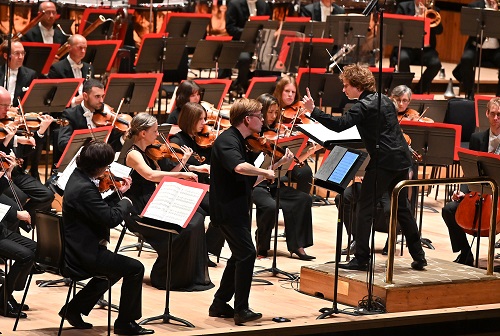 United Kingdom Sibelius, Beethoven: Pekka Kuusisto (violin), Philharmonia Orchestra / Santtu-Matias Rouvali (conductor). Royal Festival Hall, London, 2.12.2021. (CS)
United Kingdom Sibelius, Beethoven: Pekka Kuusisto (violin), Philharmonia Orchestra / Santtu-Matias Rouvali (conductor). Royal Festival Hall, London, 2.12.2021. (CS)

Sibelius – Violin Concerto in D minor Op.47
Beethoven – Symphony No.6 in F major Op.68, ‘Pastoral’
The final concert of the Philharmonia’s Human/Nature series was titled Sunlight on Water. That tranquillity-inducing image was apparently drawn from a review in The Times which described a performance by Finnish violinist Pekka Kuusisto of Sibelius’s Violin Concerto with poetic delicacy: ‘as silvery and fleeting as winter sunlight on water’. This performance of the Concerto at the Royal Festival Hall by Kuusisto and the Philharmonia Orchestra – with whom Kuusisto is the Featured Artist for the 2021/22 season – under the baton of his fellow Finn, conductor Santtu-Matias Rouvali, was less serene and rather more chilly than the concert’s title might have led one to anticipate. But, if it was bracing then it was brilliantly thought-provoking too.
I’ve heard Kuusisto play Sibelius’s masterpiece many times, most recently at the 2019 Proms with BBC Scottish Symphony Orchestra under the baton of Thomas Dausgaard. But, this performance surprised me. In 2019 we had Finnish folk band preludes; here, the improvisation was confined to Kuusisto’s encore – a folk/ring-tone inspired invention which saw Kuusisto casually riff, roam and rotate with delightful insouciance. But, the Finnish fiddler still had some unexpected tricks up his sleeve. And, Rouvali – a twin-like floppy haired flaneur – was a musical soul-brother.
It might be easier to start by explaining what we didn’t have in this performance. There was little surging Romanticism, even in the emotional peaks of the second movement; and there was an absence of orchestral plushness, or sentimental Romantic plummets into velvety darkness. There was no virtuosic posturing or drama – though plenty of effortless virtuosity. There was brightness but it was stark illumination rather than glowing warmth. There was rhythmic incisiveness, but not pointedly so. Overall, there was a sense of command: of a vision being realised, but being realised ‘in the moment’ – not pre-prepared but brought to life as it breathed. There was not really drama, in a theatrical sense, but the sense of mystery, of meandering insight. It willed one to be mesmerised. And, there was a sense of ‘breadth’ – an unhurriedness which let us take in the musical landscape, and which permitted delicacy to dance unfettered.
Kuusisto’s tone is slender and, at times, sparse. He holds his bow quite high up the stick, like the folk fiddler he is. The cool opening felt startlingly free, the Philharmonia violins’ pianissimo oscillations an electric trigger-release. The big climaxes, including the wonderful shift into Eb minor for the first rendition of the solo violin’s soulful sixths-supported melody, were broadly self-satisfied rather than sumptuous. Rouvali coolly plucked sounds and colours from the air, with a nonchalant flick of the wrist, and then let them diffuse. I wasn’t sure if the overall impression was one of relaxation or naiveté, but I was utterly persuaded.
In the first movement, Kuusisto and Rouvali had the structure ‘sorted’. There was no ‘effort’; the music simply spoke. The lack of self-indulgence continued in the Adagio di molto, which seemed to move forward quite pressingly. At times, Rouvali seemed to evoke the spirit of Finlandia – there was rhetoric from the brass but not overly so. If the music has an almost sexual intensity, then here it was of the slow-burn kind. The rhythms of the Finale had a lovely fluidity – they really danced; and, here, the Philharmonia’s string sections showed off their wonderful bowing dexterity and differentiation. It was only at the very close, when the pedal points need to buzz and burn, and the orchestral anticipation needs to sound paradoxically menacing and hopeful, that I found the orchestral sound world a little lacking in weight – and the final ‘punch’ seemed to stumble a little. This might not be the interpretation I’d want for the CD collection, but, boy, I’d like to hear it again in the concert hall.
After the interval, Rouvali led the Philharmonia on a blithe romp through the countryside. Even a thunderstorm could not quench the smiles. Beethoven’s Sixth Symphony really bubbled and babbled, a stream of joy and light-heartedness. Everything sparkled, and the musicians seemed to breathe as one. There was such freedom; questions were posed, answers were proffered. Rouvali himself was a maestro of magical movements – nothing exaggerated, everything inspired. All was right with the world. The orchestra had a big smile on its face.
But, this was not an unobservant ramble. Shifts of tempo, harmonic arguments, dynamic juxtapositions were all discerningly crafted, but with surreptitious insight and instruction. The final ‘Shepherd’s Song – happy, grateful feelings after the storm’ was a flood of joyful song, the inner voices as effervescent as the solo and principal themes were gleeful. There was a ‘glow’ at the close that I carried home with me.
Claire Seymour
A lovely and on point review, Claire. It was a pleasure to play.